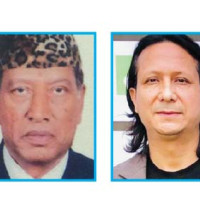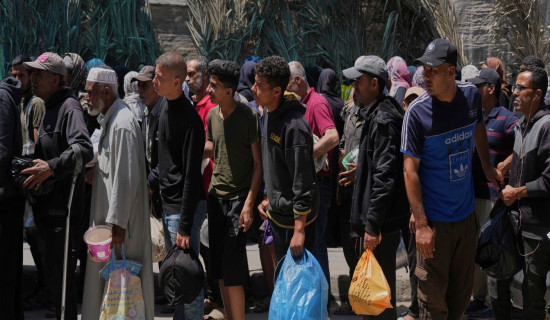- Sunday, 1 June 2025
Bel Patra: A Spiritual Legacy Of Pashupatinath
The most sanctified Hindu pilgrimage in the lap of the Himalayas, Kathmandu, is the Pashupatinath Temple. The divine play of Lord Shiva, who pierced the three worlds by creating a huge, endless pillar of light, or the Jyotirlinga, made Brahma and Vishnu, deities, understand that there was a mightier ‘third power’ that ruled the universe. All three worlds (physical, the astral, and the causal), including time and space, dissolve in Shiva, or Niranjan Nirakar (epithet of Shiva).
Purely aesthetic
The three aspects of Sada-Shiva (benefactor), the eternal Lord responsible for the creation, preservation, and destruction of the world, are represented by the trifoliate leaves (Patra) of the Bel tree (wood apple). Bel Patra, known as Bilva Patra in Sanskrit, is revered in Hinduism for its spiritual significance.
The trifoliate shape of Bel Patra is symbolic, representing various triads such as the three eyes of Lord Shiva, the third being located at the center of the forehead; the three main Gods of Hinduism (Brahma, Vishnu, and Maheshwar); and the three Gunas, or qualities of nature—sattva (purity and knowledge), rajas (self-centric), and tamas (impure intellect).
Offering Bel Patra to Lord Shiva or Rudra is a ritual or gesture of surrender of one's soul to him. Lord Shiva revealed himself as Neelkantha (the blue-throated) by swallowing the deadly poison named Halahal that emerged from the churning of the sea by the Gods and the demons to protect all beings and the existence of the universe.
The Bel Patra, imbued with the essence of sweat droplets of Goddess Parvati (or Durga), was offered to soothe the intense heat and pain caused by the deadly poison. This act endeared Bel Patra, having its aura of unique fragrance, to Lord Shiva.
Divine sanctuary
In my early childhood, when my late mother was holding my wrist and getting down the stone steps to the inner courtyard towards silver door of the temple for prayer/puja, my inquisitive sight always hastily stayed at three important images, that is, a brass sculpture of a huge bull, and to its right a stone sculpture of a huge monkey God Hanuman ji (11th Rudra Avatar of Lord Shiva) watching us with his wide-open eyes, and alongside of the Tulasi Moth (basil stand/pot) an ancient old huge Bel tree having its extended branch where ash-painted naked sadhu (ascetic) sagging in a clumsy hammock above the ground for salvation.
During every visit, standing at Chandi ko Dhoka (silver door), the moment I bowed to Lord Pashupatinath, I forgot to ask him for any fortune but was filled with the joy and ecstasy of love and devotion. Interestingly, this was identical to an incident Narendra (Swami Vivekananda) had experienced while following the suggestion of Ramakrishna Paramahansa Guru (devotee of Goddess Kali); when he bowed to Goddess Kali’s image, he was intimidated with a great feeling of devotion and love, and therefore totally forgot to pray for any financial welfare, which was worldly. For me, besides being a serene and enlightening experience, it also provided me spiritual contentment and the potency to face challenges and unrest in my social life and professional career.
Bel-patra plantation
I remember the day when I was approached by the Pashupatinath area development trust, requesting me to plant and grow a Bel Patra tree in the inner courtyard of Pashupatinath Temple opposite Hanuman ji’s tall sculpture lying at a distance. Taking 14 years of my hard work, the Bel Patra tree that I had planted in the auspicious month of Mansir 2067 BS, has now become sturdy and bushy, approximately 15 feet tall and 64 square feet in diameter. The tree is housed by an iron net, including the razor blade fencing coil for its protection.
Growing it was not an easy task amidst the minor indifferences and weary attitude of some frontline duty bearers and, of course, those damn menacing monkeys always seeking to damage it. However, in my inner experience, the tree has been watched over by the onlooking Hanuman ji, destructor of troubles—Sankat Mochan—for its safekeeping.
The Bel Patra tree is located in such a place that the aura of unique fragrance is constantly carried by the breeze flowing from the Himalayas in the north to the Jyotirlinga of Lord Pashupatinath, who often is meditating on Lord Vishnu (Ram). Actually, this new Bel tree was grown in the same place where there used to be an ancient big Bel tree that had died due to aging.
Every regular visit of mine to Pashupatinath Temple kept me focused on God's promises rather than my own problems, meaning my foremost task would be tending the Bel Patra tree to save it from any possible harm from monkeys and people who otherwise would snip leaves. I never had to return back with frustration without having somebody present to lend his/her hand to make it a successful project.
From day one, my approach was to make it a participatory activity to the extent possible for ‘ownership’ of duty bearers and devotees. Other integral activities besides the Bel Patra tree, I was blessed to initiate, are the iron net housing of the Tulasi Moth next to the Bel Patra tree to protect basil plants and the plantation of the Rudraksha tree (laeocarpus ganitrus) surrounded with an iron net and razor blade coil just outside the temple courtyard entrance.
Knowing that everything that has ever existed is owned by Lord Shiva, not making the basic provision of the required ingredients and facilities in the temple premises, such as the Bel Patra tree, would be considered a guilt. He, controlling the “nature” where human ecology manifests itself, I was simply an instrument of Lord Pashupatinath to plant and grow the Bel Patra tree to the happiness of millions of devotees who are captivated by the mesmerizing aura of the temple enhanced with the fragrance of the bushy Bel Patra tree, including Tulsi and Rudraksha.
(The author writes on integrated development issues and is also a freelancer.)

















